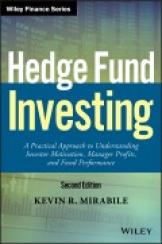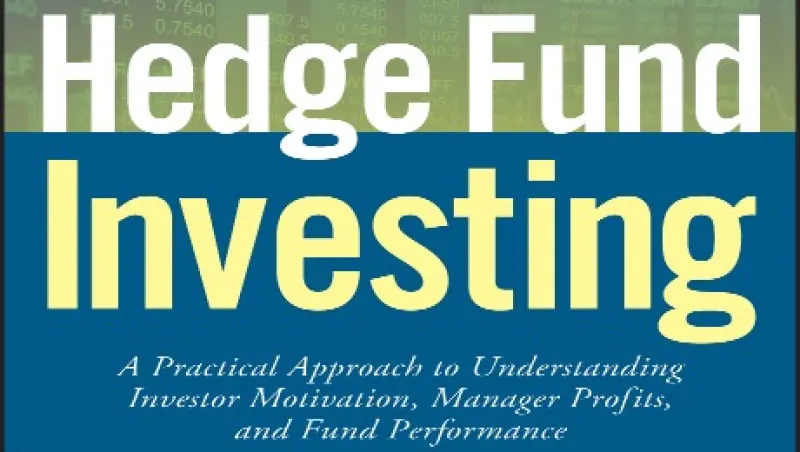
Cover image courtesy Wiley
Top-ranked hedge fund managers are among the investment world’s rock stars, their faces and names regularly splashed across the financial news. Ironically, however, exactly what these familiar figures do to earn their billion-dollar paychecks is something of a mystery to the average individual investor and not a few professionals.
Hedge Fund Investing: A Practical Approach to Understanding Investor Motivation, Manager Profits, and Fund Performance answers that question. This second edition, by Kevin Mirabile, a professor at Fordham University’s Gabelli School of Business, updates the original 2013 handbook with additional information on how funds are sold, financed and valued. The result is essentially a textbook that also can be used by investors seeking to understand an industry that is changing rapidly as it becomes more mainstream.
The handbook format makes sense. Before becoming a college professor, Mirabile was a veteran operator, buyer and seller of hedge funds, having worked at firms including Orca Investment Management, his first foray into working in the asset class, and at Larch Lane Advisors, where he was chief operating officer.
The book may be a bit basic for seasoned hedge fund investors and managers. Nonetheless, the two main sections, one describing different fund styles and the other discussing how to evaluate a fund before investing, should be essential reading for anyone who wants to invest in, work at or sell hedge funds.
With their broad range of techniques, hedge funds can — theoretically, at least — achieve positive returns in any market. More realistically, portfolio managers can wield the strategies to achieve higher absolute return while reducing risk.
In the book’s first section, Mirabile breaks down four primary styles of hedge fund investing: long-short equity; relative value, including fixed-income arbitrage; event-driven, such as investing in mergers and distressed companies; and macro, which can entail going long and short on a wide range of assets. A fifth style, multistrategy, uses any of the above strategies and sometimes invests in other hedge funds to accomplish this. Further, within each broad style are subcategories more narrowly based on segments such as emerging markets, securities like convertible bonds and specific strategies including quantitative trading.
Mirabile offers specific funds and managers as examples of many of these strategies, in the form of brief profiles. For instance, as a multistrategy fund example, he describes Chicago-based Citadel, led by founder Kenneth Griffin, who is perennially one of the industry’s highest earners.
Much of the book is devoted to telling readers how to evaluate hedge funds. Mirabile delves deeply into assessing performance, organizational structure, business skills, service providers and other aspects of fund managers. He notes that these evaluations are particularly difficult for hedge fund investors because of managers’ secrecy about their activities. He makes clear, however, the importance of investor scrutiny, with the help of repeated references to the Bernard Madoff Ponzi scheme and similar scandals. He unflinchingly compares the industry’s performance with that of traditional assets. Since 1993, he points out, hedge funds overall have returned about the same as the unmanaged, unhedged S&P 500, albeit with less volatility.
Individually, Mirabile emphasizes, funds may lose money for many reasons other than poor strategies or bad investment selection. Inadequate risk management, sketchy service providers, clumsy execution of trades and failure to adequately respond to external market events all can bring down a fund — and its investors with it.
Not surprisingly, the author is unabashedly positive about hedge funds and their role as return-boosting, volatility-smoothing alternatives to traditional assets. He accepts the healthy fees paid to hedge fund managers as necessary for encouraging performance, while warning that some managers get these fees for doing little more than traditional (and much less richly paid) mutual fund managers.
Mirabile cites studies pegging the size of the global hedge fund industry at about $3 trillion, compared with about $30 trillion for mutual funds. After weathering the post–financial crisis storm, he says, hedge funds are poised to grow further. At the same time, however, the sector may be losing vitality as institutional investors, which increasingly dominate as hedge fund investors, exhibit a marked preference for very large hedge funds and make it harder for start-ups to gain traction.
One key takeaway from the book: Studies show it is doubtful that top-ranked hedge fund managers will maintain their relative edge over time. Another is that, generally speaking, multistrategy funds have the best record of any of the styles.
Perhaps the overarching theme is that this is not an area where investors should rush in blindly or unaccompanied by expert guides. As Mirabile says when discussing direct investment in hedge funds by individual investors, “Only very sophisticated or very naive investors go down this path.” After reading Hedge Fund Investing, an investor may not yet be very sophisticated, but he or she will not be nearly as naive.
Get more on hedge funds and alternatives.





